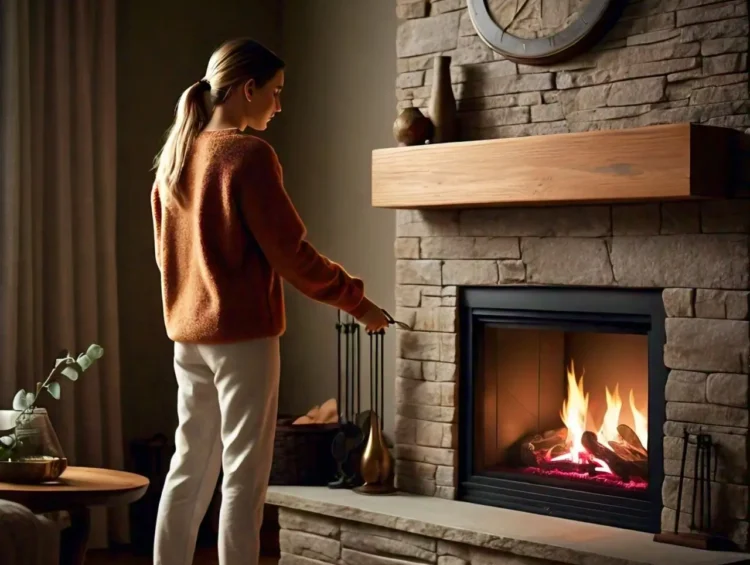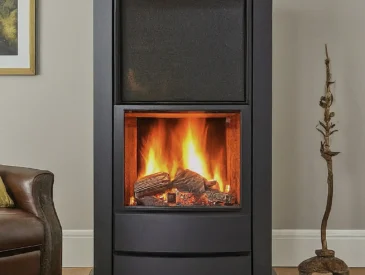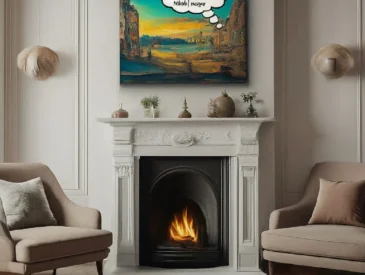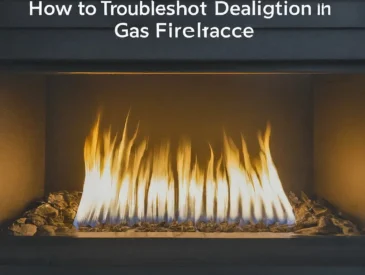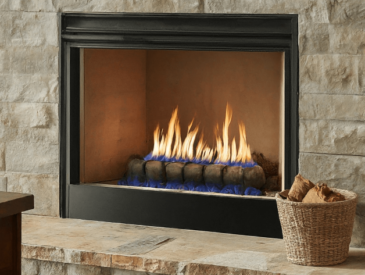Gas fireplaces have become a popular choice among homeowners due to their efficiency, clean-burning nature, and the cozy ambiance they provide. However, not everyone is aware that you can adjust the color of the flames in your gas fireplace.
In this comprehensive guide, we will take you through the steps to help you achieve the ideal flame color for your gas fireplace. Whether you’re aiming for a natural wood-like fire or a specific ambiance, we’ve got you covered.
Locate Your Gas Control Knob and Light the Fireplace
If you’ve recently installed a gas fireplace and are curious about the flame color, it’s important to know that the natural color for gas flames is blue. This blue color indicates the complete combustion of natural gas or propane.
However, gas fireplace manufacturers designed the logs and other media to burn with yellow flames and red tips to simulate the appearance of a natural wood fire.
Here’s how to light your gas fireplace:
Locate the gas control knob: The first step is to find the gas control knob. This may seem daunting if it’s your first time, but your owner’s manual will guide you on where to find and how to operate the control knob.
Ensure the gas valve is open: Make sure the gas valve is open to allow gas to flow to the fireplace.
Access the controls: Typically, the controls are located at the unit’s base. Remove the firefront or fireplace screen to access them.
Turn the control knob: Start by ensuring the control knob is in the “OFF” position. If not, turn it off and wait for a few minutes before proceeding. Then, turn the control knob from “OFF” to “PILOT.” This will ignite the pilot flame. You may also need to press a separate spark-ignition button if your gas fireplace model requires it. Keep the dial depressed for a minute after the pilot is lit and then turn it from “PILOT” to “ON.”
Confirm the pilot is lit: Verify that the pilot flame is lit, either by looking at the logs or the controls. If the pilot doesn’t light or goes out, restart the ignition process.

Allow the Flame To Burn for a While
Once the pilot flame is steady, you can replace the screen or firefront and adjust the flame’s height. Initially, the flame will appear blue, as this is the default color for natural gas. After a few minutes, it should develop yellow or orange tips.
These warm colors, while different from the natural blue, are perfectly safe for gas fireplaces. They are designed to mimic the appearance of a wood-burning fire.
3. Adjust the Damper
If your gas fireplace’s flame remains blue and doesn’t transition to yellow, it’s likely due to excess airflow. You can regulate the air circulation by partially closing the air shutter. However, it’s essential to keep the damper open while lighting the fireplace to ensure efficient ventilation.
To close the air shutter, follow these steps:
- Access the knobs: Find the knobs behind your gas fireplace’s front.
- Switch off the fireplace: Before making any adjustments, turn off the fireplace and allow it to cool down.
- Close the shutter: If your fireplace has manual controls, you can close the air shutter by turning the knob. If your fireplace has an automatic control, simply press a button to achieve the same effect.
You might also need to adjust the fireplace damper to further control airflow. The damper regulates airflow into the fireplace and controls the heat in your living area. Make sure to choose the right adjustments based on your damper type and always prioritize safety by wearing an oven glove when handling it.
4. Adjust the Pilot Flame
If the pilot’s blue base flame starts turning yellow or orange, it may indicate a soot buildup or issues with gas flow. To address this, follow these steps:
- Access the gas knob controls: Depending on your gas fireplace’s type, locate the “Lo-High” control button or adjustment screw.
- Adjust the flame color: Turn the “Lo-High” control counterclockwise or adjust the screw with a screwdriver until the desired blue flame appears.
- Hold the knob: If your gas fireplace has manual or automatic knobs for changing the flame color, select your preferred hue. Hold the knob for a few minutes to lock it in place.
5. Inspect Your Chimney or Air Vent
Sometimes, adjusting the damper, air shutter, or pilot flame may not produce the desired color if there are issues with the ventilation systems. Problems in the chimney or air vent can hinder proper airflow and flame color changes. Consider the following potential issues:
- Clogged chimney flues: Soot, debris, or creosote accumulation can obstruct the chimney flue, leading to inadequate airflow. Regular chimney maintenance is essential to avoid this problem.
- Inadequate installation: Installing gas fireplaces on old chimney systems may lead to venting issues. Proper installation is crucial to prevent inadequate drafts.
- Acids and condensation: Acid entry into the vent system or condensation inside the flue can lead to flue blockage. Insufficient airflow into the fireplace can result from this issue.
- Broken vents: Faulty vents can impede airflow into and out of the fireplace. Regular inspections are essential to identify any vent issues.
6. Clean the Fireplace
In the case of vent-free gas fireplaces, a flame color other than blue indicates incomplete combustion, which can pose health hazards due to soot or carbon monoxide production. Such discoloration is often caused by dirt or dust particles in the fireplace.
To adjust the flame color in a vent-free gas fireplace by cleaning the burner:
- Turn off the fireplace: Follow the manufacturer’s instructions to turn off the fireplace, either by using the control knob or a remote control.
- Locate the burner: Remove the fireplace screen to access the burner, which is usually in the middle of the fireplace.
- Inspect the burner: Check the burner and gas logs for dirt or soot. If the burner is dirty, clean it using a vacuum cleaner or a brush with fine, soft bristles.
- Restore the fireplace screen: After cleaning, put the screen back on and turn on the fireplace. The flame should now be blue.
If you still observe a yellow or orange flame, consider calling a professional to inspect your gas fireplace, as there may be underlying issues.
7. Monitor Carbon Monoxide Levels
Most gas fireplaces, especially ventless ones, are equipped with carbon monoxide detectors. These detectors alert you to the presence of carbon monoxide when your fireplace is in use.
Different alarm sounds convey various messages:
- One beep every minute: Indicates a low battery.
- Four beeps and a pause: Signify the presence of carbon monoxide.
- Five beeps every minute: Suggest that the detector is faulty and needs replacement.
If you notice a change in flame color from blue to yellow and hear four beeps from the alarm, turn off the fireplace immediately, as this indicates carbon monoxide production. Contact a professional to inspect and rectify any issues promptly.
8. Change the Fuel
If none of the previous methods yield the desired flame color, you can consider changing the fuel source for your gas fireplace. For instance, if you were using natural gas, you can switch to propane.
If you prefer the look of a natural wood fire, you can transition to wood as your fuel source. However, note that this option is only viable if your fireplace is vented, as ventless fireplaces require professional adjustments to install a ventilation system.
In conclusion, gas fireplaces offer flexibility in achieving your desired flame color, whether it’s the natural blue flame or warm yellow and orange tones.

Each method mentioned above serves to help you create the perfect ambiance for your living space. It’s important to prioritize safety by following manufacturer instructions and seeking professional assistance when necessary. Enjoy the cozy atmosphere of your gas fireplace, tailored to your preferences.

